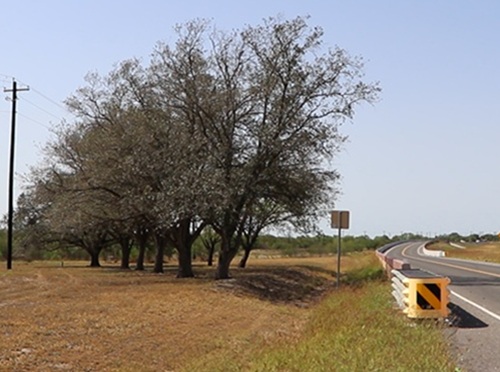Six years ago, construction crews were preparing to remove a set of trees from alongside a highway project overseen by the Texas Department of Transportation. That is, until the agency learned that these weren’t just any trees; they were clones of the famous “Treaty Oak” in Austin, TX.
[Above photo by TxDOT]
Located in Treaty Oak Park in Austin’s West Line Historic District, the roughly 500-year-old “Treaty Oak” is the last living member of the Council Oaks; a grove of 14 trees that served as a sacred meeting place for Comanche and Tonkawa tribes.
Yet, as crews prepared to remove a grove of trees by a house along the US 281 Relief Route near Premont, TX, in 2019, TxDOT received a letter indicating that those trees were cuttings from the actual Treaty Oak made by local arborist Wash Storm, known as the “King of the Live Oaks.”
He made those cuttings after the poisoning of the original Treaty Oak in 1989 in act of vandalism – viewing the cuttings as a way to keep this piece of “living history” alive in some form.
“These trees are what I would consider to be one of the smaller stories that kind of make up Texas history,” noted Kimberly Amy, a TxDOT environmental project planner, in a recent blog post.
“So this is one of those smaller stories that I believe should be saved, should be retold,” Amy said. “Because you’re talking about someone that had an incredible amount of integrity and was selfless and wanted future generations to enjoy heritage trees. And we need people like that.”
Fortunately, the real Treaty Oak tree in Austin survived its poisoning – something that wasn’t expected when Storm planted his grove of Treaty Oak clones. [Incidentally, the vandal – Paul Cullen – was apprehended shortly after reportedly bragging about poisoning the tree to cast a spell. He was convicted of felony criminal mischief and sentenced to serve nine years in prison.]
However, even located far away from their biological parent, the cloned trees thrived in South Texas. And, after hearing about the historical significance of these cloned trees, TxDOT’s project team found a way to save them – shifting the new road and building a wall to protect them.
“We understood that this was something that was going to be important,” Amy said. “And I’m very proud [that TxDOT] was responsive to the fact that this was important to the community.”
Across the country, state departments of transportation are involved in a variety of efforts to preserve not only local history but local cultures as well.
For example, archaeologists with the Maryland Department of Transportation recently showed off a trove of “interesting artifacts” found at the Ben Ross home historical dig site; the place where the father of Civil War-era abolitionist Harriet Tubman lived and where she spent her teenage years in Dorchester County.
The agency said its archaeologists spent the past four years processing hundreds of artifacts collected from the Ross home, which is deep in the wetlands of the Blackwater National Wildlife Refuge.
In August 2024, the North Carolina Department of Transportation – in partnership with N.C. State University’s Institute for Transportation Research and Education – launched a two-year project aimed at mapping unmarked burial sites belonging to historically marginalized groups statewide.
In October 2022, the Kentucky Transportation Cabinet helped establish a new website highlighting more than 100 prehistoric and historic archaeological sites across the state’s 64 counties. The agency launched that website – Discover Kentucky Archaeology – in collaboration with the Kentucky Heritage Council-State Historic Preservation Office, an agency of the Kentucky Tourism, Arts, and Heritage Cabinet.
Additionally, in January 2022, the Colorado Department of Transportation debuted a documentary called “Durango 550 – Path of the Ancestral Puebloans” to show how the agency worked with archaeologists and regional Native American tribes to document, study, and ultimately share the discoveries unearthed near Durango in southwest Colorado.




